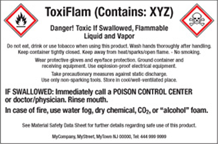





Return to news>>Workplace Labeling under the GHS
Apr 08, 2016
We are in the final stages of the Hazard Communication Standard update period. First, manufacturers were to update the MSDS to the newer version- the SDS. Manufacturers were also responsible for reclassifying the hazards of the chemicals and generating new GHS Compliant Labels. The deadline for these updates has passed (June 2015) and the current phase of updated compliance falls on the users of the chemicals to have the updated information.
Enter some confusion on labeling.

GHS compliant labels have the following elements (where applicable): pictograms, hazard statements, precautionary statements, signal words, product identifier, and supplier information. These labels may look like this:
GHS labels are required for transport, import, and export. Meaning, if you manufacture a chemical and ship it out, then a GHS label is required. If a chemical is transported from one location to another (leaves the building), then a GHS label is required. The information for a GHS label can be found in section 2 of the SDS.
Up until the GHS came along, many employers used the NFPA or the HMIS label as workplace labeling. These systems are meant to identify the chemical and to alert the user as to what the general hazard is; this uses a 0-4 scale rating to indicate the severity.
Workplace labeling includes the labels that are on containers at a place of employment. If you have received a shipment of chemicals, then the manufacturer should have already done the labeling for you. However, those other-than-original containers that you then use for storage or for transfer containers that need a label- these are considered workplace labels. For example, we have a client who uses pigments in their process. These pigments come to them in a large drum that has a GHS label on it. They then take that pigment and transfer it to multiple smaller containers for dispensing throughout process lines. They use the HMIS labels with supplemental information as their workplace labels.
The confusion we have seen in the field is the assumption that EVERY container in the workplace must now have a GHS label on it. This is not entirely the requirement. An employer is more than welcome to include a GHS label on every container within the workplace, but the Hazard Communication Standard allows for alternate labeling in the workplace as long as it meets certain criteria (my notes are inserted in red):
The goal is to have employees understand what the chemical is within the container and what hazards that chemical poses. The label must effectively communicate this. This all should be supplemented with the information in an SDS for that chemical that should be available to all employees.